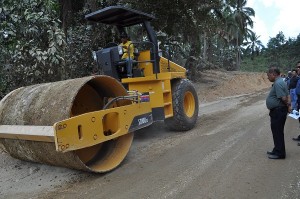
A government road project in El Nido in Palawan. The Philippines ranked a “mediocre 113th” for the overall state of its public infrastructure, with particularly low marks for the quality of its seaports and airports, in the 2012 Global Competitiveness Report of the World Economic Forum, according to the Department of Public Works and Highways. PHOTO FROM DPWH.GOV.PH
MANILA, Philippines—On a scale of 1 to 7—with 1 being extremely underdeveloped and 7 extensive and efficient by global standards—roads in the Philippines scored a low 3.1 in the 2012 Global Competitiveness Report of the World Economic Forum, according to the Department of Public Works and Highways.
In a DPWH report furnished the Philippine Daily Inquirer, the agency also disclosed that out of the 139 countries worldwide, the Philippines ranked a “mediocre 113th” for the overall state of its public infrastructure, with particularly low marks for the quality of its seaports and airports.
Except for Vietnam, which scored a much lower 2.6, other countries in the region garnered the following scores on the quality of their roads: Singapore, 6.5; Hong Kong, 6.2; South Korea and Japan, both 5.8; Malaysia, 5.7; Taiwan, 5.6; Thailand, 5; China, 4.4; Indonesia, 3.5; and India, 3.4.
The DPWH pointed out that “the Philippines is lagging behind its neighbors in the Association of Southeast Asian Nations in terms of quality infrastructure and in particular, the quality of roads.”
“Although there has been an improvement from the 2010-2011 Global Competitiveness report, the Philippines is still behind except for Vietnam, which may not be for long due to heavy investments in infrastructure going on in that country,” it said.
With public investments of nearly P700 billion, the DPWH has expressed confidence the Philippines’ ranking would improve before the end of President Aquino’s term in June 2016.
“Of the total investment requirement of P698 billion, at least P585.93 billion is earmarked for the highways sector (from 2011 to 2016),” said the DPWH report.
From P75.04 billion in 2011, the agency is spending another P81.2 billion this year on national roads, followed by P91.7 billion in 2013, P101.3 billion in 2014, P113.7 billion in 2015 and P122.9 in 2016.
Public Works Secretary Rogelio Singson has called upgrading the quality and safety of national road infrastructure in the country as “one of the DPWH priorities.”
According to Singson, “the national road network is the most important infrastructure asset of the government.”
“An indicative estimate of the national road network asset is valued at P1.2 trillion. The road network provides the connectivity to all Filipinos for their economic and social activities. As such, the President has directed DPWH to ensure that the quality and safety of our national road network are upgraded and maintained properly. DPWH funding for our national roads and bridges is being increased substantially to ensure continued economic growth nationwide,” he noted.
Budgetary support until 2016 has been intended to achieve the DPWH’s key targets, said Singson.
The DPWH aims to “pave by 2014 all existing unpaved roads out of the 15,872 kilometers of national arterial roads, and by 2016, pave all existing unpaved roads out of the 15,370 kilometers of national secondary roads.”
National arterial roads refer to the “main trunkline from northern Luzon to southern Mindanao, interconnecting major islands,” while national secondary roads are “other roads complementing national arterial roads that also provide access to main population centers.”
In the same report, the DPWH said the government would look at Malaysia “as a benchmark in terms of quality of roads.” With a road network of over 98,720 kilometers, 1,821 km of which are expressways, the Asean country’s infrastructure is one of the most developed in the region.
Its longest highway, the North-South Expressway in Peninsular Malaysia, extends over 800 km, linking the Thai and Singaporean borders.
The DPWH also aims to “make all bridges on national roads of permanent structure by 2016.”
By the same year, the department also targets the following: rehabilitation of 58,592 meters of national bridges; widening of 12,236 meters of existing bridges; construction of 18,255 meters of new bridges; and replacement of 19,725 meters of damaged bridges.
On upgrading the quality of national roads and bridges, the DPWH’s policies and programs include the “adoption of new standards for concrete pavement thickness from 230 mm to 280 mm, outsourcing project inspection and quality assurance, developing new construction design standards and specifications, and strengthening or retrofitting of bridges to comply with international seismic standards.”
On improving road safety, the agency has been “constructing loading and unloading bays, using Traffic Accident Recording and Analysis System and the International Road Assessment Program, assessing 2,500 km of national roads that are considered as ‘high risk’ roads, enforcing anti-overloading provisions of the law, and clearing of road hazards, illegal structures and obstructions along national roads.”

